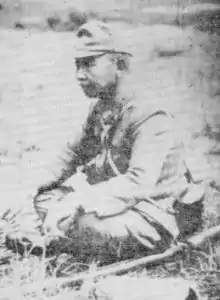Toshinari Shōji
Toshinari (or Toshishige) Shōji (東海林 俊成, Shōji Toshinari (Toshishige), October 27, 1890 – December 10, 1974) was a major general in the Imperial Japanese Army during the Pacific campaign in World War II.
Toshinari Shōji | |
|---|---|
 Toshinari (Toshishige) Shōji[1] | |
| Native name | 東海林 俊成 |
| Born | October 27, 1890 Sendai, Miyagi, Japan |
| Died | December 10, 1974 (aged 84) |
| Allegiance | |
| Service/ | |
| Years of service | 1912-1945 |
| Rank | |
| Commands held | 230th Infantry Regiment |
| Battles/wars | World War II Netherlands East Indies campaign Guadalcanal campaign |
Biography
A native of Miyagi Prefecture, Shōji graduated from the 25th class of the Imperial Japanese Army Academy in 1912. He subsequently graduated from the Army Staff College in 1912.[2]
Shōji was promoted to rank of colonel on August 1, 1939.[1] Beginning in 1941, he commanded the IJA 230th Infantry Regiment, sometimes called the Shōji Detachment,[1] which was part of the 38th Division. From February through March 1942, this unit participated in the invasion of Java as part of the Netherlands East Indies campaign.[3] There, his unit captured an airfield on the day of his landing in the Battle of Kalijati and later launched a successful gamble to break through Dutch fortifications surrounding Bandung in the Battle of Tjiater Pass, leading to the Dutch capitulation.[4]
In October 1942, he and his regiment were deployed to Guadalcanal as part of the strategically significant Guadalcanal Campaign. After participating to a minor degree in the Battle for Henderson Field, Shōji's regiment took heavy losses in the Koli Point action, Carlson's Patrol, and Battle of Mount Austen, the Galloping Horse, and the Sea Horse.[5]
Surviving the eventual Japanese defeat in the campaign and withdrawal from Guadalcanal, Shōji was promoted to major general in March 1944. After his return to the Japanese home islands in 1945, he was appointed commander of the Sendai Area Command under the Japanese Fifth Area Army in the final stages of World War II.[2]
In the aftermath of the war, Shōji was sent to Batavia to stand trial for war crimes committed against prisoners of war and civilians by men under his command in the Netherlands East Indies, and was sentenced to death on January 1949. His sentence was reduced in December to 10 years of imprisonment, and he was sent to Sugamo Prison in Tokyo.[6] He died in December 1974.
References
- Frank, Richard (1990). Guadalcanal: The Definitive Account of the Landmark Battle. New York: Random House. ISBN 0-394-58875-4.
- Fuller, Richard (1992). Shokan: Hirohito's Samurai. New York: Arms and Armour Press. ISBN 1-85409-151-4.
- Griffith, Samuel B. (1963). The Battle for Guadalcanal. Champaign, Illinois, US: University of Illinois Press. ISBN 0-252-06891-2.
- Rottman, Gordon L. (2005). Duncan Anderson (ed.). Japanese Army in World War II: The South Pacific and New Guinea, 1942-43. Oxford and New York: Osprey. ISBN 1-84176-870-7.
External links
- Ammentorp, Steen. "Shoji Toshishige, Major-General". The Generals of World War II.
- L, Klemen (1999–2000). "Forgotten Campaign: The Dutch East Indies Campaign 1941-1942".
- Hough, Frank O.; Ludwig, Verle E.; Shaw, Henry I. Jr. "Pearl Harbor to Guadalcanal". History of U.S. Marine Corps Operations in World War II. Retrieved 2006-05-16.
- Shaw, Henry I. (1992). "First Offensive: The Marine Campaign For Guadalcanal". Marines in World War II Commemorative Series. Retrieved 2006-07-25.
- Zimmerman, John L. (1949). "The Guadalcanal Campaign". Marines in World War II Historical Monograph. Retrieved 2006-07-04.
Footnotes
- L, Klemen (1999–2000). "Colonel Toshishige Shoji". Forgotten Campaign: The Dutch East Indies Campaign 1941-1942.
- Ammenthorp, The Generals of World War II
- L, Klemen (1999–2000). "The conquest of Java Island, March 1942". Forgotten Campaign: The Dutch East Indies Campaign 1941-1942.
- Boer, P. C. (2011). The Loss of Java: The Final Battles for the Possession of Java Fought by Allied Air, Naval and Land Forces in the Period of 18 February - 7 March 1942. NUS Press. pp. 488–500. ISBN 978-9971-69-513-2.
- Frank, Guadalcanal: The Definitive Account of the Landmark Battle
- Borch, Fred L. (2017). Military Trials of War Criminals in the Netherlands East Indies 1946-1949. Oxford University Press. pp. 184–186. ISBN 978-0-19-182296-4.